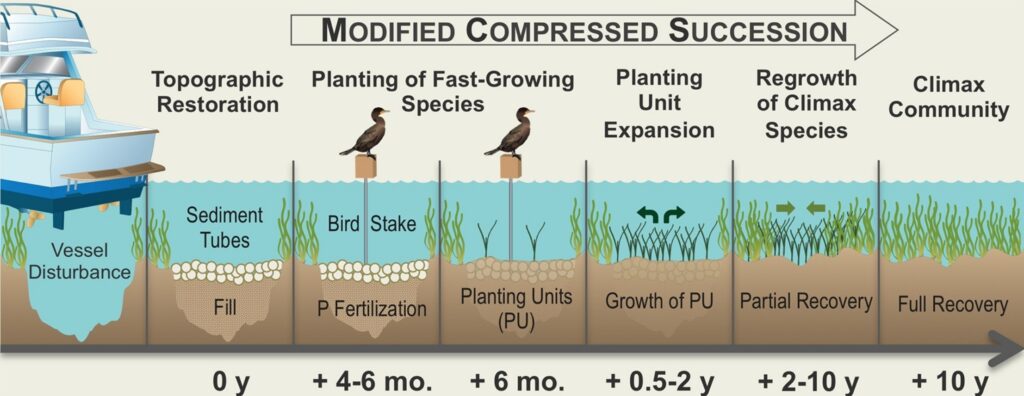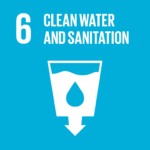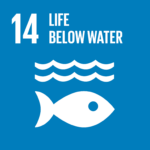Growth behavior - Due to the growing nature of seagrass rhizomes - a horizontal underground stem that laterally develops from the grasses’ nodes, allowing it to spread and grow upwards across the sea floor - seagrasses cannot grow down into and across trenches, holes and scars created by anchor or propellers. Therefore, filling in these gaps with sediment based tubes returns the scars to the same elevation as the surrounding meadow (source).
Tube material - These sediment tubes contain fine sands that would otherwise be washed away by currents, so need to be enclosed in a material loose enough to be penetrated by neighboring seagrass rhizomes for recolonization. This fabric material will also biodegrade after a period of about 6 to 12 months, depending on water temperature and other environmental factors. For example, US-based company Seagrass Recovery, Inc. has created and patented the Sediment Tube, a biodegradable cotton tube that is filled with sediment and laid directly into propeller scars (see website here).
Materials required
- Sand or other sediment
- Tube-shaped cotton bag
- Snorkel equipment
- Marked posts or buoys
- Boat
- GPS system (optional)
- Seagrass transplants or seeds
Steps of implementation
- Seed collection: First, the collection of fertile shoots or mature seagrass fruits from more healthy sites. These collected shoots are then put in large seawater tanks for several weeks until most seeds have been released and then separated from other organic debris and stored until usage.
- Mapping: identify and measure individual scars within damaged seagrass meadows using highly accurate GPS.
- Filling the tubes: From the GPS, produce the required number of sediment tubes from long cotton fabric filled with fine sand that are transplanted from elsewhere. Sediment tubes can be fertilized with seeds and have seagrass transplants added to them to increase speed of recovery.
- Placing the tubes: Transport sediment tubes out to the site using a shallow draft barge or boat. The use of a snorkel diver to help navigate exactly where the sediment tubes should be placed underwater is beneficial for more murky or waters that are deeper than 1 m.
- Bird stake demarcations: It is important to clearly mark the replanting areas with posts or stakes to warn future boaters of the shallow grass flat and to reduce future scarring. An additional benefit of having posts over parts of these tubes is that they encourage sea birds to perch on top of them, which then naturally fertilize the tubes below with guano, accelerating restoration in parts.
- Monitor after a period of about 6 to 12 months, monitor the site to track the return of seagrass into the restored scars and whether the cotton tubes have biodegraded.

(Source)
Considerations for application
Shape & weight - A single tube is approximately 1.5 m long, 15-20 cm in diameter, and weighs approximately 15kg when filled with crushed calcium carbonate sand (see website here).
Permit legislation - Due to being at sea, a permit will most certainly be required for doing restoration work on seagrass meadows.
Labor - A longstanding limitation in seagrass restoration is the high labor costs associated with collecting and implementing the restoration material, transplants and seeds. This cost can be greatly reduced by engaging “citizen scientists” or volunteers for restoration projects, which is common to several projects across the East coast of Africa and the UK.
This intervention contributes to:



- Boat-damaged meadows, St. Joseph Bay, Florida
St. Joseph Bay, Florida, USA, sediment tubes are being used to restore propeller scars in the St. Joseph Bay Aquatic Preserve as part of the Deepwater Horizon NRDA Early Restoration Phase III Project. This initiative, led by the Central Panhandle Aquatic Preserves (CPAP), aims to repair boat damage to shallow seagrass beds, particularly in turtle grass (Thalassia testudinum) habitats in the Florida Panhandle. The project will restore at least two acres of seagrass habitat by placing sediment tubes into identified propeller scars. Around 45,000 sediment tubes have been deployed across 370 scars to raise the scarred areas to natural elevations, creating suitable conditions for seagrass regrowth. CPAP staff will monitor the progress of these restoration efforts over the next three years.


